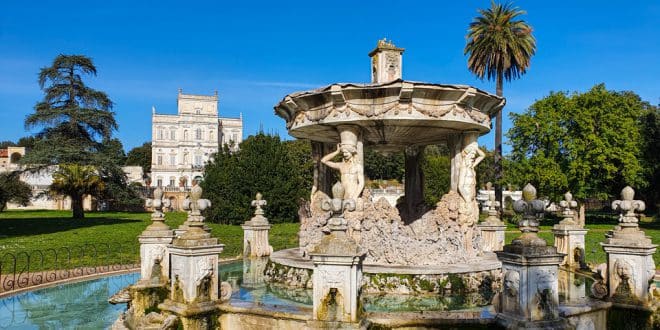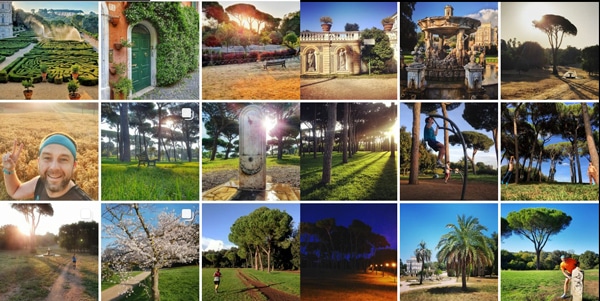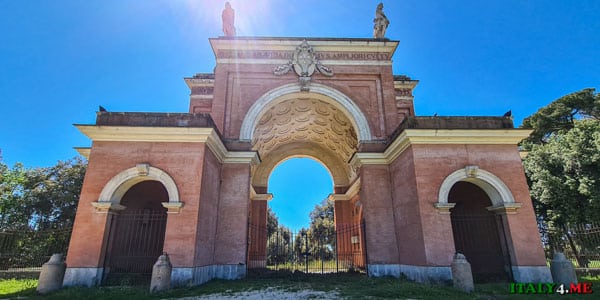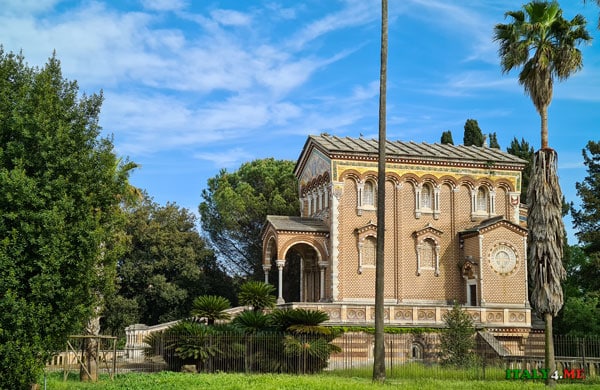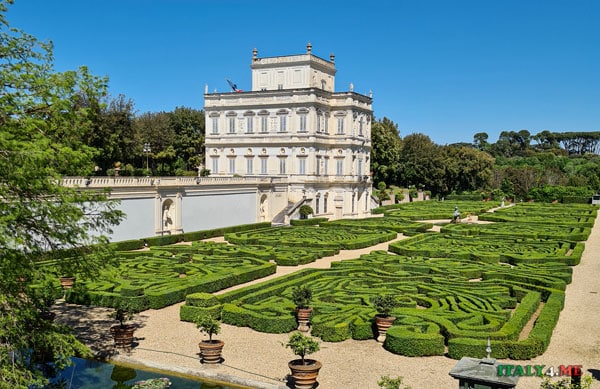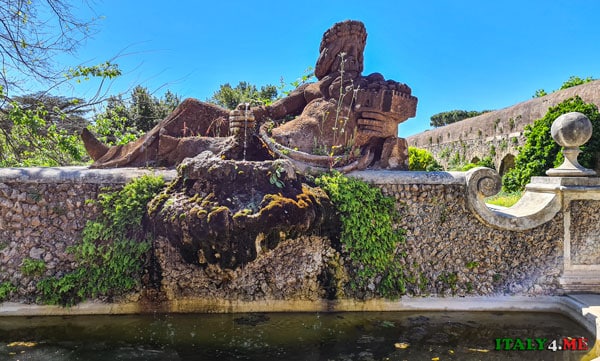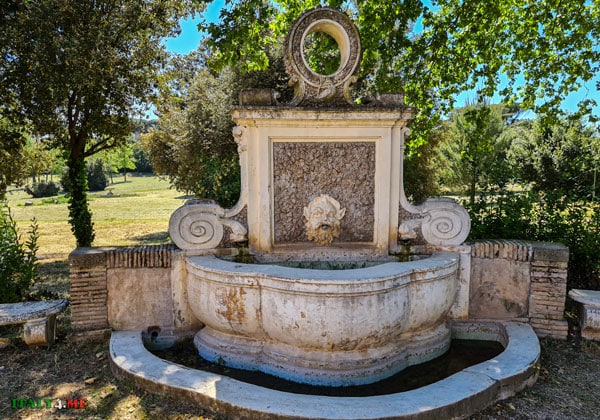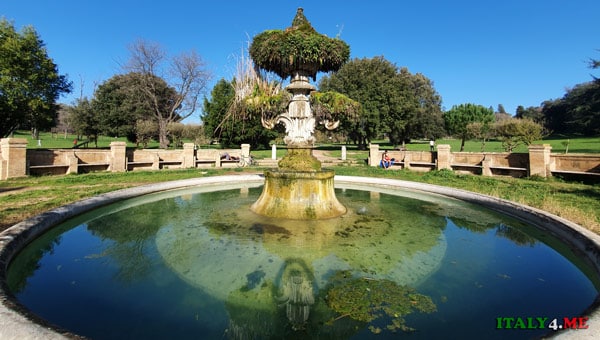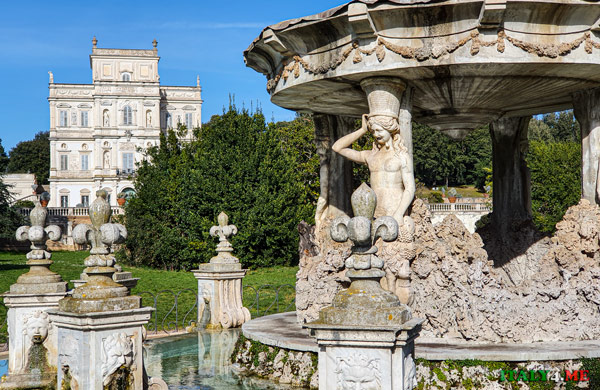Villa Doria Pamphilj – a 17th-century palace and park complex located on the Gianicolo hill, one and a half kilometers south of the Vatican.
This country estate of an ancient lineage, with its vast green park occupying 184 hectares, is the largest in Rome. Since 1972, it has been accessible for visits and is cherished by city dwellers and tourists as a place for relaxation and connection to the history of Italy.
Page Contents
History
At the beginning of the 17th century, the area of Villa Doria Pamphilj was a modest estate with vineyards and a small building known as Villa Vecchia.
In 1630, the old estate was purchased by Pamphilio Pamphili – a member of a noble Roman family whose wife Olimpia Maidalchini, known as Pimpaccia, became famous as a bright and extraordinary personality of the 17th century.
In 1644, their son Camillo Pamphili began the construction of a palace on the acquired lands, envisioned as a luxurious country residence.
Pope Innocent X from the Pamphili family, aiming to glorify and immortalize his surname, brought in the talented sculptor and artist Alessandro Algardi to work on the palace-park complex. Although not an architect, his talent and ambition to overshadow even Giovanni Lorenzo Bernini (Giovanni Lorenzo Bernini) fully emerged in the planning and creation of Villa Pamphilj.
Algardi enlisted painters and architects Giovanni Francesco Grimaldi, Carlo Rainaldi, and Francesco Borromini, who had already distinguished themselves in Rome with their Baroque creations.
Between 1644 and 1653, the central part of the new villa, named Casino del Bel Respiro (House of Fresh Air), the central fountains, and the restoration of Villa Vecchia were completed. The beautiful park added a special allure to the country villa; its first landscape was designed by Tobia Aldini.
After the noble line of the Pamphilj ended in 1760, the vast country estate passed to the Doria family, leading to the villa’s double name.
The last significant construction in the park was a chapel, built between 1896 and 1902 by Edoardo Collamarini, which remains the property of the Doria-Pamphilj family to this day.
From 1883 to 1971, the palace-park complex was partially sold by the heirs of the Doria-Pamphilj family to the municipality of Rome and then wholly confiscated by the Italian government.
For those interested in life in Rome, I invite you to follow a my Instagram Special hashtag.
Architectural Features
The main building of the architectural complex of Villa Doria Pamphilj is Casino del Bel Respiro, whose interior houses a unique family collection consisting of notable works of art, artifacts (including those found on the villa’s territory), furniture, and remarkable frescoes by Giovanni Francesco Grimaldi.
The entrance to the park is marked by the monumental Arco dei Quattro Venti (Arch of the Four Winds), built according to the design of Italian architect Andrea Busiri Vici between 1856 and 1859, partially using materials from the eponymous Casinodel Villa Corsini, destroyed in 1849 during the battles between French troops and defenders of the Roman Republic.
Of interest are the 19th-century Greenhouses (Serre Ottocentesche) – a structure in Neo-Gothic style, designed and built between 1846 and 1847 by Giovanni Guj. The original building has retained its function, and its three halls – cold, temperate, and warm – currently house exotic fruits, particularly pineapples.
The Doria Pamphilj Chapel (Cappella Doria Pamphilj) and several buildings related to the farm estate are within the park grounds.
Landscape
Magnificent and diverse gardens lend a special charm to the ancient villa.
To the south of Casino del Bel Respiro opens the most beautiful corner of the estate – the Secret Garden (Giardino Segreto), adorned with a boxwood labyrinth featuring patterns in the shape of the heraldic fleur-de-lis of the Pamphilj family.
The territory of the most extensive garden, Valle dei Daini (Valley of the Deer), previously belonging to Villa Corsini and covering about 60,000 square meters, was originally vineyards. In the mid-19th century, the vast area was planted with pines, oaks, elms, willows, and poplars. The ancient trees remember when roe deer, deer, and pheasants, specially introduced for the hunting pleasures of the Roman aristocracy, roamed the garden.
The landscape’s diversity is enriched by the citrus tree garden Giardino del Cedrati, the Theatrical Garden (Giardino del Teatro), and the 19th-century Greenhouse Garden (Giardino delle Serre Ottocentesche) with exotic palms of various species.
Fountains
No fashionable garden of the 17th – 19th centuries was complete without splendid fountains by famous masters. In the park of Villa Doria Pamphilj, one can admire the Snail Fountain (Fontana della Lumaca) by Giovanni Lorenzo Bernini, as well as creations by Alessandro Algardi and Giovanni Francesco Grimaldi — the Tiber Fountain (Fontana del Tevere)
the Venus Fountain (Fontana di Venere), the Mascherone Fountain (Fontana del Mascherone)
and the Lily Fountain (Fontana del Giglio).
The Grand Fountain-Waterfall (Fontana della Cascata) is a complex structure with three pools, from which water flows into the Lily Lake. The lake is home to fish, and turtles and swans swim in it, which visitors love to feed.
The magnificent Cupid Fountain (Fontana del Cupido), built in 1855 by Andrea Busiri Vici, is monumental and fascinating.
The winged cupid, named after the sculptural composition, was stolen shortly after Villa Doria Pamphilj was opened to the public. Now, only the legs of the statue remain on the pedestal that crowns the balustrade. The fountain composition consists of a large round basin with an impressive base, supported by four pillars, propped up by figures of fauns – men and women.
The decoration of the twelve rectangular columns features heraldic lilies, and their front and side faces are adorned with heads of Gorgon, from whose mouths water flows into the shells.
How to Get There, Opening Hours
Villa Pamphilj is open daily from 07:00 until sunset.
The nearest entrance to the city center is located at Largo III Giugno, 1849 – the intersection of Via di S. Pancrazio and Via Aurelia Antica. The entry point is marked in our Rome Guide App, the map of which is available without an internet connection. It’s a 7-minute walk from the Acqua Paola fountain (Fontana dell’Acqua Paola).
Remember that the villa is huge, and you can easily spend an entire day there. I recommend stocking up at the supermarket with slices of cheese, prosciutto, and wine and setting up a picnic under the pine trees.
 Italy for me From Italy with love
Italy for me From Italy with love

